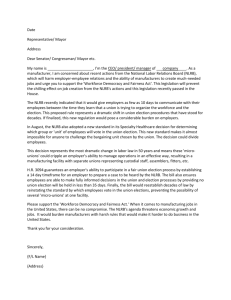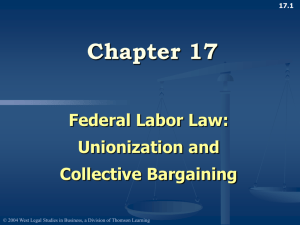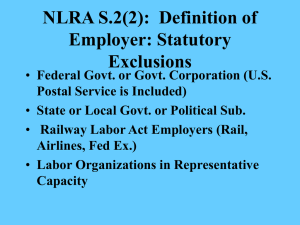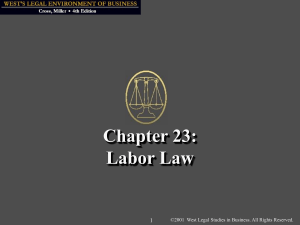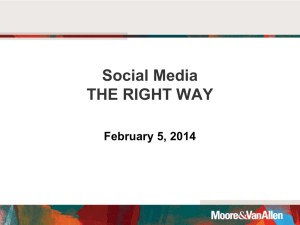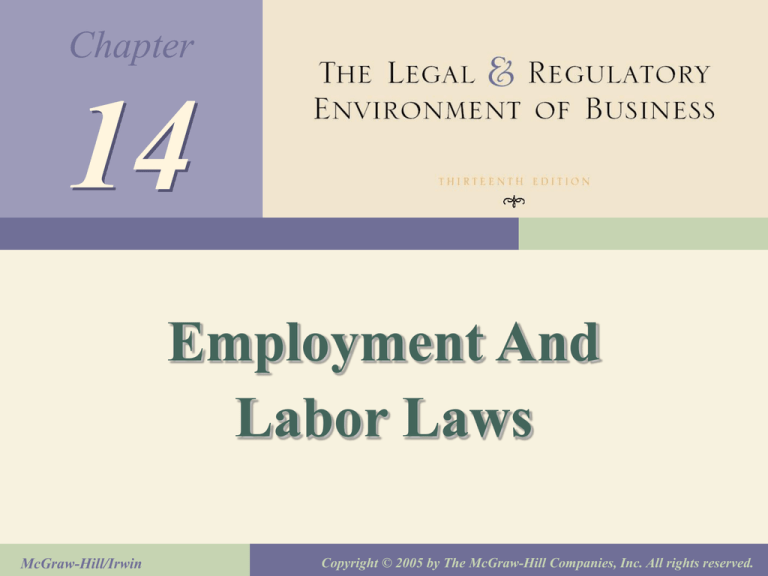
Chapter
14
Employment And
Labor Laws
McGraw-Hill/Irwin
Copyright © 2005 by The McGraw-Hill Companies, Inc. All rights reserved.
Major Federal Employment Laws
See Summary Chart of Laws and Purpose of
Laws on page 414
14-2
Health & Safety
Worker’s Compensation- For work-related
injuries
• Without regard to fault
• Arise out of employment and In course of
employment
• logic:compromise to provide
compensation/limit awards
• Employer required to furnish medical
treatment
• Schedule of disability payments
• Some employees excluded
• In practice, burdensome process for
employees
14-3
Health & Safety
Occupational Safety & Health Act
(OSHA)(1970)
• General duty to prevent workplace hazards
that may cause death or serious harm
• Reporting requirement
• Must comply with set labor standards
• Inspections may be random, but generally
in response to complaints
• Search warrants may be required
14-4
Health & Safety
Family & Medical Leave Act(1993)
• To provide job security
• 50 or more employees
• 1 year of service
• Up to 12 weeks per year, Unpaid
• Time may be split up
• Serious health condition
Affecting Normal Activities
14-5
Wages & Pensions
Fair Labor Standards Act(1938)
• Restrictions On Child Labor
• Minimum Hourly Wage- 1997 = $5.15/hr.
• Maximum Number Of Hours Before
Overtime Owed
• 40 Hours (1.5 Regular Rate)
• Time Off
• May Be Superceded By Contract
Rules currently under challenge, in re
“Salaried”
14-6
Wages & Pensions
State Wage Statutes
• Garnishment (e.g. for Child Support)
• Note: Doctrine of Preemption
14-7
Wages & Pensions
Employment Retirement Income Security Act
(ERISA)(1974)- vesting
• To protect pension funds from:
Underfunding
Dishonest or Careless Management
Loss upon change of employers by
Long-Term employees
Much litigation
14-8
Wages & Pensions
Social Security Act
• Provides Disability Benefits
14-9
Employment-At-Will
Unless contract for a definite period, can
discharge without cause at any time
• Contract Theory: Implied Promise Of Good
Faith
Handbook = Contract?
• Prohibited
Discharge For Performance Of Public Obligation
Discharge For Whistle-Blowing (various acts
including Sarbanes-Oxley)
Discharge For Exercising Legal Rights
“Public Policy”
See chart of other limitations on page 417
14-10
Employee Privacy
Electronic Communications Privacy Act (1986)
Lie Detector Tests - generally prohibited or highly regulated
• Employee Polygraph Protection Act of 1988
allows testing when there is a "reasonable suspicion" that the
employee is involved in activity resulting in economic loss or
injury to the employer. Also when the employer is a securityrelated firm or is involved with controlled substances.
Drug Testing - regulated by statute
• Fourth Amendment Search & Seizure
• NC Controlled Substance Examination Act
• DOT/NRC Rules
Other Privacy Concerns (Employee Access/Restricted 3rd Party Access)
• Personnel Records
• Medical Records
• Email
14-11
Employee Privacy
GARRITY v. JOHN HANCOCK MUTUAL LIFE INSURANCE
COMPANY
2002 U.S. Dist. Lexis 8343 (D. Mass. 2002)
FACTS: Nancy Garrity and Joanne Clark were terminated as
employees of John Hancock in July 1999. The reason given for
these discharges was violations of the company’s e-mail policy.
The company, upon investigation, determined these individuals
had used company e-mail to send sexually explicit messages.
Mrs. Garrity and Ms. Clark sued John Hancock for wrongful
discharge. They alleged the company’s investigation violated
their rights of privacy. The basis of these claims rests on the
company’s instructions for employees to create password
protection to their e-mail and to create personal folders for
messages sent and received.
ISSUE: Is John Hancock entitled to summary judgment on the
merits of the employees’ claims?
14-12
Employee Privacy
GARRITY v. JOHN HANCOCK MUTUAL LIFE
INSURANCE COMPANY
2002 U.S. Dist. Lexis 8343 (D. Mass. 2002)
DECISION: Yes.
REASONS: 1. The company has a legitimate business interest in
protecting its employees from inappropriate e-mail messages.
•
2. Once the company receives complaints about
sexually explicit e-mails, it is required by law to investigate.
•
3. The plaintiffs in this case cannot satisfy the claims of
defamation by the company since the company has a conditional
privilege to share information, as needed, that arises from and
furthers the investigation of employees allegedly violating the
company’s e-mail policy.
14-13
Employee Privacy
In a recent survey one-third of
companies said that they have
fired an employee in the past 12
months for violating email
policies. Another 52% said they
had disciplined employees for
email policy violations. (Source:
Marketwatch)
14-14
Employer Protection
From Employee Lawsuits
“Paper Fortress”
• Job Descriptions
• Personnel Manuals
• Personnel Files
• Written Warning- Signed/Noted
• Letter Of Explanation
• Key Considerations: Documentation &
Witnesses
14-15
Collective Bargaining &
Union Activities
See Summary of Laws Governing
Labor-Management Relations on
page 422
14-16
Labor-Management
Relationship
Collective Bargaining
• Clayton Act (1914) (1) That the antitrust laws do not apply to labor
unions that are carrying out legitimate labor
activities such as striking and picketing.
(2) That the act prohibits federal courts from
enjoining certain lawful labor activities.
14-17
Labor-Management
Relationship
A union and several employers negotiated a collectivebargaining agreement which restricted the operating hours of
food-store meat departments in Chicago, Illinois, to 9:00 a.m.
through 6:00 p.m. Jewel Tea brought suit, alleging that a
prepackaged, self-service system of marketing meat
eliminated the need to have a butcher on duty at all times;
therefore, the limitation on operating hours was an
unreasonable restraint of trade. The defendants claimed that
the controversy was exempt from the antitrust laws. Issue:
Does the antitrust laws apply? Held: No. Exempt under the
Clayton Act. The national labor policy expressed in the
National Labor Relations Act immunizes from the Sherman Act
union-employer agreements on when, and how long,
employees must work. The agreement herein is thus exempt.
Local Union No. 189, Amalgamated Meat Cutters, and Butcher
Workmen of North America, AFL-CIO, et al. v. Jewel Tea
Company, Inc., 85 S.Ct. 1596 (1965).
14-18
Labor-Management
Relationship
Collective Bargaining
• Railway Labor Act(1926) - For Railroads &
Airlines (see box on page 423)
That state courts cannot enjoin a peaceful strike by
employees covered by the Railway Labor Act.
Also, employees under the Railway Labor Act have
the right to strike over major disputes but are
subject to compulsory arbitration for minor
disputes before the National Railroad Adjustment
Board.
14-19
Labor-Management
Relationship
Collective Bargaining
• Railway Labor Act(1926) - For Railroads & Airlines
15 times in the last 30 years Congress had to dictate the terms of a
railroad settlement or extend the time period during which strikes or
lockouts are prohibited. Congress has to act because the lengthy
negotiation and mediation procedures of the Railway Labor Act
frequently do not result in an agreement. In 1992, the Congressional
resolution of a strike and lockout that had shutdown all railroads
provided:
a. For a 38-day cooling off period with continued negotiations.
• b. If no agreement, then binding arbitration was required.
• c. In the arbitration process each side would make a final offer of
settlement. The arbitrators then would select one or the other offer
and it would be imposed on both parties. They could not
compromise between the offers. (Similar to baseball arbitration.)
14-20
Labor-Management
Relationship
Collective Bargaining
• Norris-LaGuardia Act(1932)
(1) That the Norris-LaGuardia Act attempts to
limit the power of the federal courts to issue
injunctions.
(2) That the act does not restrict state courts
from issuing injunctions
Yellow-Dog Contracts
14-21
Labor-Management
Relationship
Collective Bargaining
• Norris-LaGuardia Act(1932)
• A Union, which represents railroad employees nationwide, had a
dispute over renewal of a collective-bargaining agreement with a
small railroad that is a subsidiary of a large railroad. After
exhausting the settlement procedures mandated by RLA, the
Union instituted a lawful strike against the parent railroads. The
Union extended its picketing to other railroads with which the
parent interchanged traffic. Issue: Can the court enjoin this
secondary picketing? Held: No. Under the Norris-LaGuardia
Act, a federal court did not have the jurisdiction to enjoin
secondary picketing in railway labor cases. Burlington Northern
R. Co. v. B.M.W.E., 107 S.Ct. 1841 (1987).
14-22
Labor-Management
Relationship: Wagner Act(1935)
Created National Labor Relations Board
Business “Affecting Commerce”- Small Employers
Under State Laws
• See Chart of Jurisdiction page 425
Granted NLRB Quasi-Judicial Authority
Note: That public employees are not covered by
the act. Public employees are subject to state law
in the settlement of their labor disputes.
See other exemptions in box on page 425
14-23
Unfair Labor
Practices- Employer
Interfering with employee’s right to form/join
union
• “Concerted Activities” liberally interpreted to favor
union formation
Establishing/dominating union
Hiring/Tenure discrimination based on union
involvement
Discriminating against employees based on
NLRB charges filed/testimony given
Refusing to bargain in “Good Faith” with
union that represents employees
14-24
(compulsory/voluntary)
Unfair Labor
Practices- Employer
ALLENTOWN MACK SALES AND SERVICE, INC. v. NATIONAL
LABOR RELATIONS BOARD
118 S.Ct. 818 (1998)
FACTS: A factory branch of Mack Trucks, Inc. had service and parts employees represented
by the International Association of Machinists and Aerospace Workers. This branch was
sold by Mack Trucks, Inc. to the managers of the facility. These managers believed that
their employees were no longer interested in being represented by the union. The new
owners refused to recognize the union as the bargaining agent for the employees.
Management also requested the NLRB to conduct an independent poll by secret ballot
concerning the union’s status. The poll was conducted. The Union lost the poll, but it filed
a charge of an unfair labor practice by management.
ISSUE: Does the NLRB use the same standard of “reasonable doubt” by the employer when
management requests a poll, when management requests a decertification election, and when
management withdraws its recognition of the union as the bargaining agent of employees?
14-25
Unfair Labor
Practices- Employer
ALLENTOWN MACK SALES AND SERVICE, INC. v. NATIONAL
LABOR RELATIONS BOARD
118 S.Ct. 818 (1998)
DECISION: Yes.
REASONS:
1. The NLRB has discretion in setting standards with respect to
polls, elections, and recognition withdrawals.
2. Since the NLRB has discretion, setting a unitary standard is
within its authority.
3. In this case, there is sufficient evidence that Allentown managers
did in fact have reasonable doubt about the support or lack of
support of the union as the bargaining agent of its employees.
14-26
Bargaining
Compulsory
Permissive
Drug and Alcohol Testing
for Current Employees
Layoffs
Recalls
Work Quotas
Profit-Sharing Plans
Health Plans
Cafeteria Prices
Early Retirement Packages
Plant Relocations
Advertising
Promotions
Product - Design
Drug and Alcohol Testing
for Applicants
14-27
Labor-Management
Relationship: Wagner Act(1935)
A union
refused to work overtime during
negotiations for renewal of a contract.
The
employer filed a complaint with a state employment
relations commission that entered a cease and
desist order. The state courts upheld the order.
Issue: Does the state have jurisdiction over this
labor dispute? Held: No. The union's concerted
refusal to work overtime was peaceful conduct
constituting activity that must be free of state
regulation if the congressional intent in enacting
the comprehensive federal law of labor relations
was not to be frustrated.
Lodge 76, Etc. v.
Wisconsin Employment Rel. Com'n., 96 S.Ct. 2548
(1976).
14-28
Unions
Elections
• Secret Ballot
Maynard Plastics
Example
• NLRB Supervised Upon
Petition
• Certification
14-29
Unions
NLRB v. KENTUCKY RIVER COMMUNITY CARE, INC.
121 S.Ct. 1861 (2001)
FACTS: The Kentucky River Community Care, Inc. operates a facility,
known as Caney Creek, for the care of patients suffering from mental
retardation and illness.
The Kentucky State District Council of
Carpenters, a labor union, petitioned the NLRB for certification as the
bargaining representative of the eligible employees at Caney Creek. A
dispute arose concerning the supervisory status of six registered nurses.
The NLRB’s Regional Director decided the burden to prove supervisory
status is always on the employer. Upon appeal, the Sixth Circuit reversed
and announced the burden of proving supervisory status is always on the
NLRB’s General Counsel. The NLRB was granted review by the Supreme
Court.
ISSUES: 1. Should courts defer to the decisions of the administrative
agency?
2. In this case, who has the burden of proving supervisory
14-30
status?
Unions
NLRB v. KENTUCKY RIVER COMMUNITY CARE, INC.
121 S.Ct. 1861 (2001)
DECISIONS:
• 1.Yes, generally courts should not discount the decision made at the
administrative level.
• 2.The NLRB’s General Counsel has the burden of proof in this case.
REASONS:
• 1. The Wagner Act does not explicitly state who has the burden of
proving an employee’s supervisory status.
• 2. It is appropriate for the NLRB to fill in the gap left by the statute.
The NLRB has ruled that the party seeking to show a presence or
lack of supervisory status has that burden of proof.
• 3. The Sixth Circuit should defer to the NLRB’s ruling, rather than
create an absolute rule that the NLRB’s General Counsel always has
the burden of proof.
• 4. In this case, the Sixth Circuit’s conclusion that the General
Counsel has the burden of proof is correct.
14-31
Collective Bargaining &
Union Activities
Taft-Hartley Labor-Management Relations Act(1947)
• To Ensure the Flow of Commerce
Recently employed in re: California Dock Workers
• Vs. unfair labor practices
• Monitored by NLRB
• 80 day cooling off period where threat to harm national safety or
•
•
•
•
•
•
health (e.g. California Dock Workers strike)
Anti-Closed Shop - Need not join union prior to hire
Union Security Clause - Must join after hire (Child World Example)
Employer Free Speech
Right-to-work laws -Need not join if hired pre-union
See Chart of Unfair Practices on page 437
See Local 14 v. NLRB,
Right to strike, picket, collectively bargain
Right of reinstatement
• But misconduct can justify discharge
14-32
Right-To Work States
14-33
Member Suits Against Unions
Union Responsible For
Actions Of Its Agents
Money Judgment Against
Union Assets
Members
• Sue For Damages From Illegal
Strike
• Sue For Breach Of Duty In Fair
Representation
• Failing To Enforce Union
Constitution & Bylaws
14-34
Unfair Labor
Practices- Union
Coerce employee to join/select representative
Coerce employer to discriminate in hiring non-union
employee
Refuse to bargain with employer
Setting excessive union fees
Forcing employer to pay for work not performed
Requiring employer to bargain with non-certified
bargaining agent
Striking/Picketing For Illegal Purposes, Engaging In
Secondary Boycotts- Jurisdictional Strike
14-35
Amendments
Landrum-Griffin Act (1959) - “Bill
of Rights” for Union Members
Agreeing To Engage In
Secondary Boycotts
• Union-Mgmt. Agreement With
Adverse Affect On 3rd Party
• Hot-Cargo Contract
Picketing When Not Certified
• Employer Recognize Another Union
• Valid Election Already Conducted
• Unreasonable Picketing Timeframe
14-36
Collective Bargaining &
Union Activities
Labor-Management
Reporting & Disclosure
Act(1959)
• To promote honesty and
democracy in unions
• Note: Unions in decline
(Why?)
14-37
Workers Unionized
25.0%
20.1%
20.0%
18.0%
16.0% 14.9%
13.5% 13.2%
15.0%
10.0%
5.0%
0.0%
1983
Source: Bureau of Labor Statistics
1985
1990
1995
2000
2002
14-38
% Union Membership
by Industry (2002)
40
35
30
25
20
15
10
5
Service
Construction
Manufacturing
Transportation &
Public Util.
Wholesale/Retail
Government
0
Source: Bureau of Labor Statistics
14-39
Unemployment Insurance Law
Claimant’s Qualification for Benefits
• Discharge - No substantial fault or
misconduct
Misconduct - wilful or wanton disregard
of an employer’s interests, deliberate
violations, disregard for standards of
behavior which employer has right to
expect, repeated carelessness/negligence
= to wrongful intent or design = 2 year
disqualification
Unemployment Insurance Law
Misconduct specifically includes:
• loss of required license where within power
•
•
•
•
•
•
to retain
significant alcohol or drug impairment at
work
consuming alcohol or illegal drugs at work
conviction for manufacturing, selling or
distributing a controlled substance
failure of a drug test administered according
to statutory procedures
refusal to take a drug test where reasonably
required
failure to apply for suitable work
Unemployment Insurance Law
Claimant’s Qualification for Benefits
• Substantial Fault -Acts or omissions over which
Claimant exercised reasonable control which
violate requirements of the job(e.g. attendance
violations) but not:
• Minor infractions, unless repeated after
warning
• Inadvertent mistakes
• Insufficient skill, ability or equipment
• Normally 9 week disqualification
• May be mitigating or aggravating
circumstances
Unemployment Insurance Law
Claimant’s Eligibility for Benefits
• Able & Available
Shift Restrictions
Failure to accept suitable work
Failure to conduct work search
Late reporting/Filing
School attendance
Pending SSI application or grant of SSI benefits
negates eligibility
Unemployment Insurance Law
Claimant’s Qualification for Benefits
• Quit - For” Good Cause”
attributable to the employer
Good Cause = Reason which
would be deemed valid by
“reasonable” people and not
indicative of unwillingness to
work
Unemployment Insurance Law
Claimant’s Qualification for Benefits
• Quit - For” Good Cause” attributable to the
employer
Exceptions
• Personal or Immediate Family
Health/Disability, with proper notice, no
alternative work
• Solely due to permanent, unilateral reduction
in pay > 15%, or reduction in hours > 20%,
where no malfeasance, misfeasance or
nonfeasance
• Spousal Relocation - 2 week disqualification

